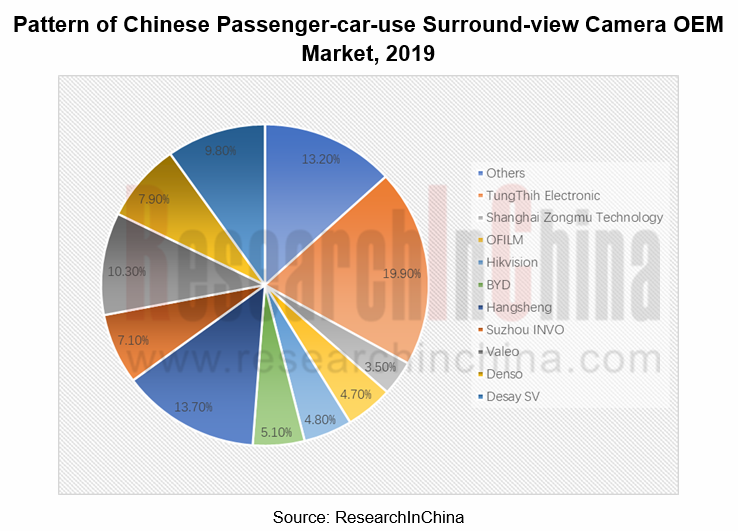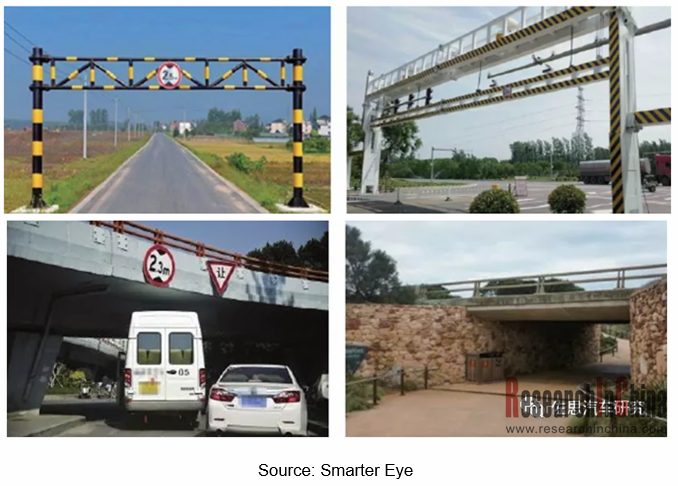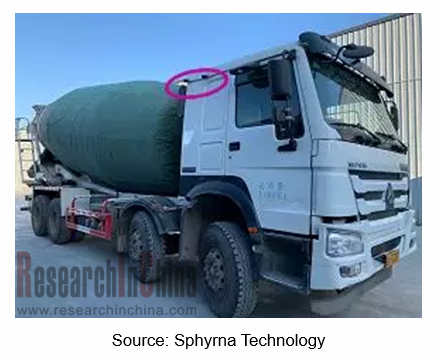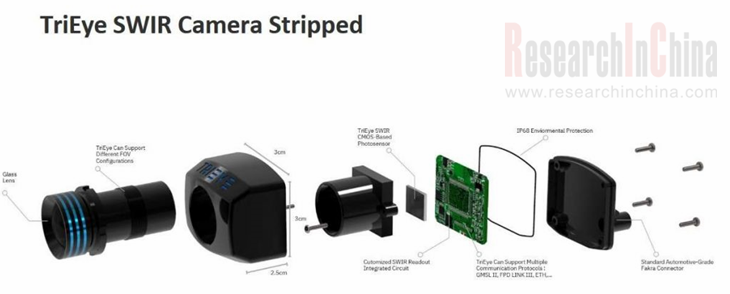Visual Perception Algorithms Become Crucial
Automotive cameras are divided into perception cameras and video cameras, according to Sunny Optical.
Perception camera, used for active safety (generally for forward and inward view), captures images accurately. Video camera, suitable for passive safety (typically surround view and rear view), stores or sends the captured images to the user. They are totally different in imaging quality and temperature reliability.
For lane detection, signal light detection, road sign recognition, in-vehicle monitoring, etc., any errors in the images taken by perception cameras will issue in software calculation errors and inevitable consequences. In this sense, perception camera is less sensitive to price.
Video cameras, with not so high a demanding on performance, are very sensitive to price; there exists a price war in this market where numerous Chinese companies are fiercely scrambling for meager profits but the vast majority do not make money. As per the pattern of Chinese passenger-car-use surround-view camera OEM market in 2019, the market share of vendors is quite scattered, a sharp contrast to the top 6 players holding a combined over 90% of the front-view monocular camera market.

Forward-view cameras require complex algorithms and chips. A forward-view monocular camera costs nearly RMB1,000, and a forward-view binocular camera over RMB1,000. Rear-view, side-view and in-built cameras has the unit price at RMB200 or so.
Breakthroughs in Binocular Camera
Chinese startups have made dramatic breakthroughs in binocular cameras, especially for commercial vehicle and special vehicle.
Smarter Eye has shipped more than 10,000 binocular cameras, mainly available in Apollo autonomous vehicles, JMC small buses, sanitation vehicles, autonomous boats, tractors, patrol vehicles, etc. Smarter Eye’s binocular cameras are typically rendered for AEBS and detection of height limiters. The bus groups in more than 30 cities have employed such cameras.
Smarter Eye pioneers in applying binocular cameras to detect height limiters. Both conventional height limiters and non-standard height limiters such as small archways and culverts in the countryside can be accurately perceived by binocular cameras that promptly warn drivers by sound and light alarms. Recreational vehicles, special vehicles, etc. have rigid demand for this function.

In 2019, Sphyrna Technology announced it successfully developed a flexible binocular camera system which can use two separate monocular cameras to accomplish a binocular camera system, overcoming inherent defects (large size, complicated process, difficult installation, and high cost) of binocular cameras.

The two cameras are independently fixed on the right side of the car body, needing neither rigid connection in the middle nor strict requirements on angle or spacing. The "flexible binocular cameras" lie in self-calibration technology. Even if the cameras slightly deform and move during use, Sphyrna Technology's algorithms will automatically detect and recalibrate, dispensing with regular recalibration essential to conventional binocular cameras.
In April 2020, Foresight Autonomous Holdings Ltd. announced to collaborate with FLIR Systems Inc. on the development, marketing and distribution of Foresight’s QuadSight? vision system, combined with FLIR Systems’ infrared cameras, to a wide range of prospective customers. Foresight will exclusively purchase its thermal cameras from FLIR for all systems to be commercialized worldwide. Foresight’s unique QuadSight system, comprised of four thermal and visible-light cameras, showcases the capability of FLIR thermal cameras to greatly improve ADAS and autonomous vehicle safety through improved situational awareness at night, in high-contrast scenes and in bad weather. The data fusion between the two stereo channels can effectively avoid the non-reporting or false-reporting under the extreme conditions like the tunnel entrance where light changes quickly.
Millimeter-wave radar is beating other sensors. The same is true of cameras. Many companies like MAXIEYE are attempting to replace binocular cameras or liDAR by using monocular cameras for ranging and 3D imaging.
Unlike the first-generation product -- IFVS-200 series based on machine learning solutions, MAXIEYE’s 3rd-Gen product IFVS-500 family based on deep learning technology achieves monocular ranging and 3D scanning. IFVS-500 not only allows monocular vision products to perform 3D scanning like lidar, but also resembles lidar by scanning the 3D point cloud within 50 meters, enabling direct ranging of the object and detection of both motor vehicles within 200 meters and pedestrians & small obstacles within 100 meters.
Visual Capabilities under Extreme Scenarios Heighten
Whatever vision inside or outside the car in poor lighting and even the dark requires infrared technology. ON Semiconductor's RGB-IR image sensor features near infrared (NIR) enhanced images. Israeli start-up TriEye has developed a sensor technology for short-wave infrared (SWIR) which enhances safety in vehicles fitted with assistance systems or autonomous driving functions by improving the ability to see in weather conditions where visibility is poor, such as dust, fog, murky conditions or rain, and to stay alert to the danger (like icy road) in advance.

In April 2020, Alibaba DAMO Academy revealed that it has developed an ISP processor for in-vehicle cameras. Through the use of it, the car camera has a significant improvement in image object detection and recognition capabilities by more than 10% compared to the mainstream processor in the night, the most challenging scene, and the original obscure labeling can be clearly identified, according to the drive test results of the DAMO Academy Automated Driving Laboratory.
On May 19, 2020, OmniVision announced the expansion of its Nyxel near-infrared (NIR) technology into the automotive market with the new 2.5-megapixel OX03A2S image sensor. This ASIL-B sensor is intended for exterior imaging applications that operate in low to no ambient light conditions within 2 meters of the vehicle. It can detect and recognize objects that other image sensors would reportedly miss under extremely low lighting conditions.

Visual Perception Algorithms Become Crucial
The massive data incurred by the dramatic increment of vision sensors in smart cars as well as the addition of vision sensors has brought challenges and opportunities to algorithm processing.
For the visual perception system, Mobileye, a leader of visual ADAS algorithms, gets a multitude of independent perception algorithms used simultaneously to create internal redundancy layers for both detection and measurements with higher perception accuracy and stability. Detection is to determine what object is perceived, and measurements are to infer the 3D information of the perceived object via the 2D image of the camera.
For detection, Mobileye uses 6 independent engines:
- 3DVD or 3D Object Detection: It is the common approach of predicting a 3D bounding box using a neural network from the 2D image.
- Full Image Detection: It deals with the common scenario where an object (such as buses cars or trucks) is extremely close and can only be partially seen. Object classification using visual signatures is used to track close up vehicles in this scenario.
- Top View FS: It focuses on identifying and marking the unoccupied roads in the screen.
- Features Detection: This appearance-based engine detects vehicles from reliable features, such as wheels.
- VIDAR: It is an approach that uses multiple views of the environment to triangulate and create a depth map. That depth map is converted into a point cloud and LiDAR based processing algorithms are used on that point cloud.
- Scene Segmentation (NSS): It is a neural network-based approach to break the scene down into free space and semantic objects (vehicle, sign, pedestrian, etc.), the pixels containing an object are treated as a detection.

Also as a leader in visual perception algorithms, Tesla names its deep learning network as HydraNet which involves 48 different neural networks that output 1,000 distinct tensors (predictions) at each timestep; in theory, HydraNet can detect 1,000 objects simultaneously. Tesla acquired DeepScale, a Silicon Valley startup that focuses on developing computer vision technologies, in a bid to improve its algorithmic capabilities.
To catch up with Tesla and Mobileye in visual perception algorithms, OEMs and Tier1 suppliers are expanding their teams of software engineers. The algorithmic capabilities will be one of the decisive factors to the performance of visual perception.
Autonomous Driving Domain Controller and Central Computing Unit (CCU) Industry Report, 2025
Research on Autonomous Driving Domain Controllers: Monthly Penetration Rate Exceeded 30% for the First Time, and 700T+ Ultrahigh-compute Domain Controller Products Are Rapidly Installed in Vehicles
L...
China Automotive Lighting and Ambient Lighting System Research Report, 2025
Automotive Lighting System Research: In 2025H1, Autonomous Driving System (ADS) Marker Lamps Saw an 11-Fold Year-on-Year Growth and the Installation Rate of Automotive LED Lighting Approached 90...
Ecological Domain and Automotive Hardware Expansion Research Report, 2025
ResearchInChina has released the Ecological Domain and Automotive Hardware Expansion Research Report, 2025, which delves into the application of various automotive extended hardware, supplier ecologic...
Automotive Seating Innovation Technology Trend Research Report, 2025
Automotive Seating Research: With Popularization of Comfort Functions, How to Properly "Stack Functions" for Seating?
This report studies the status quo of seating technologies and functions in aspe...
Research Report on Chinese Suppliers’ Overseas Layout of Intelligent Driving, 2025
Research on Overseas Layout of Intelligent Driving: There Are Multiple Challenges in Overseas Layout, and Light-Asset Cooperation with Foreign Suppliers Emerges as the Optimal Solution at Present
20...
High-Voltage Power Supply in New Energy Vehicle (BMS, BDU, Relay, Integrated Battery Box) Research Report, 2025
The high-voltage power supply system is a core component of new energy vehicles. The battery pack serves as the central energy source, with the capacity of power battery affecting the vehicle's range,...
Automotive Radio Frequency System-on-Chip (RF SoC) and Module Research Report, 2025
Automotive RF SoC Research: The Pace of Introducing "Nerve Endings" such as UWB, NTN Satellite Communication, NearLink, and WIFI into Intelligent Vehicles Quickens
RF SoC (Radio Frequency Syst...
Automotive Power Management ICs and Signal Chain Chips Industry Research Report, 2025
Analog chips are used to process continuous analog signals from the natural world, such as light, sound, electricity/magnetism, position/speed/acceleration, and temperature. They are mainly composed o...
Global and China Electronic Rearview Mirror Industry Report, 2025
Based on the installation location, electronic rearview mirrors can be divided into electronic interior rearview mirrors (i.e., streaming media rearview mirrors) and electronic exterior rearview mirro...
Intelligent Cockpit Tier 1 Supplier Research Report, 2025 (Chinese Companies)
Intelligent Cockpit Tier1 Suppliers Research: Emerging AI Cockpit Products Fuel Layout of Full-Scenario Cockpit Ecosystem
This report mainly analyzes the current layout, innovative products, and deve...
Next-generation Central and Zonal Communication Network Topology and Chip Industry Research Report, 2025
The automotive E/E architecture is evolving towards a "central computing + zonal control" architecture, where the central computing platform is responsible for high-computing-power tasks, and zonal co...
Vehicle-road-cloud Integration and C-V2X Industry Research Report, 2025
Vehicle-side C-V2X Application Scenarios: Transition from R16 to R17, Providing a Communication Base for High-level Autonomous Driving, with the C-V2X On-board Explosion Period Approaching
In 2024, t...
Intelligent Cockpit Patent Analysis Report, 2025
Patent Trend: Three Major Directions of Intelligent Cockpits in 2025
This report explores the development trends of cutting-edge intelligent cockpits from the perspective of patents. The research sco...
Smart Car Information Security (Cybersecurity and Data Security) Research Report, 2025
Research on Automotive Information Security: AI Fusion Intelligent Protection and Ecological Collaboration Ensure Cybersecurity and Data Security
At present, what are the security risks faced by inte...
New Energy Vehicle 800-1000V High-Voltage Architecture and Supply Chain Research Report, 2025
Research on 800-1000V Architecture: to be installed in over 7 million vehicles in 2030, marking the arrival of the era of full-domain high voltage and megawatt supercharging.
In 2025, the 800-1000V h...
Foreign Tier 1 ADAS Suppliers Industry Research Report 2025
Research on Overseas Tier 1 ADAS Suppliers: Three Paths for Foreign Enterprises to Transfer to NOA
Foreign Tier 1 ADAS suppliers are obviously lagging behind in the field of NOA.
In 2024, Aptiv (2.6...
VLA Large Model Applications in Automotive and Robotics Research Report, 2025
ResearchInChina releases "VLA Large Model Applications in Automotive and Robotics Research Report, 2025": The report summarizes and analyzes the technical origin, development stages, application cases...
OEMs’ Next-generation In-vehicle Infotainment (IVI) System Trends Report, 2025
ResearchInChina releases the "OEMs’ Next-generation In-vehicle Infotainment (IVI) System Trends Report, 2025", which sorts out iterative development context of mainstream automakers in terms of infota...